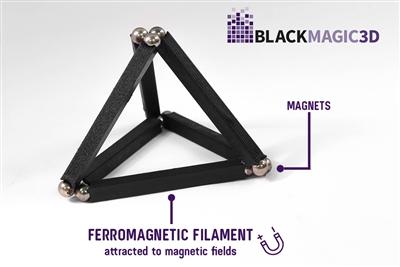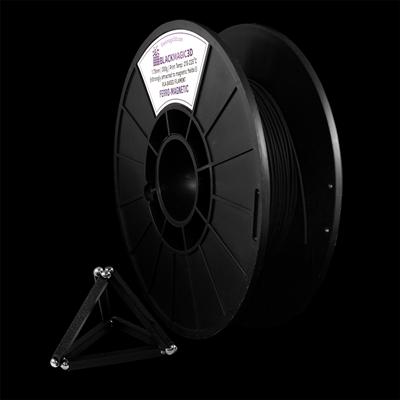 It’s been a few weeks since we’ve written about Graphene 3D Lab, which is kind of unusual; since their inception in 2014, they’ve been steadily pumping out new product after new product, patent application after patent application. The 3D printing industry, and the technology industry in general, has been buzzing about graphene as a “miracle material,” and Graphene 3D Lab has been way out in front of everyone else in the race to start printing with it. They haven’t yet developed a pure graphene filament, but they have incorporated the material into several of their products, including a conductive graphene/PLA composite filament.
It’s been a few weeks since we’ve written about Graphene 3D Lab, which is kind of unusual; since their inception in 2014, they’ve been steadily pumping out new product after new product, patent application after patent application. The 3D printing industry, and the technology industry in general, has been buzzing about graphene as a “miracle material,” and Graphene 3D Lab has been way out in front of everyone else in the race to start printing with it. They haven’t yet developed a pure graphene filament, but they have incorporated the material into several of their products, including a conductive graphene/PLA composite filament.
 In addition to working with graphene, the company has developed a line of filaments in a variety of specialty materials, including wood, glow in the dark, and, of course, conductive. Their latest product is a magnetic filament, which is now available from Graphene 3D Lab’s filament store, BlackMagic3D, as well as from Amazon. Made from a ferro-magnetic PLA material, the iron-based filament is described as being ideal for 3D printing industrial components such as sensors, motors and mechanical actuators.
In addition to working with graphene, the company has developed a line of filaments in a variety of specialty materials, including wood, glow in the dark, and, of course, conductive. Their latest product is a magnetic filament, which is now available from Graphene 3D Lab’s filament store, BlackMagic3D, as well as from Amazon. Made from a ferro-magnetic PLA material, the iron-based filament is described as being ideal for 3D printing industrial components such as sensors, motors and mechanical actuators.
“It has always been the objective of Graphene 3D to create new opportunities for 3D printing. With every functional filament we introduce to the market, the types of 3D projects that can be successfully printed expands exponentially,” said Elena Polyakova, Co-CEO of Graphene 3D. “As this filament is ideally suited to switches, sensors and actuators, we also expect this new functionality will challenge more traditional manufacturers to examine incorporating more 3D printing technology into their manufacturing processes.”
The magnetic filament is available in 1.75 mm diameter, in 350-gram quantities for $39.99. The color is flat black, giving printed objects a cast iron appearance. Because of the iron content, the filament is more brittle and abrasive than standard PLA, so expect some increased wear on your nozzle; Graphene 3D Labs suggests doing a first level adjustment and using a larger or wear-resistant nozzle for longer prints. Unlike other iron products, however, it’s unlikely to rust.
The filament really does carry a powerful magnetic charge; for best results, Graphene 3D Labs recommends using neodymium iron boron (NdFeB) or samarium cobalt (SmCo) magnets with it. The filament prints at a temperature of 215° to 225° Celsius; a heated bed can be used at 60° but is not required. Print speed is about 60 to 80 mm/s.
 Besides the numerous industrial applications the filament is expected to lend itself to, it has a lot of potential in education. Magnets are fun by themselves, but having kids 3D print their own magnets is another great way to incorporate 3D printing into science classes. And Graphene 3D Labs isn’t done yet.
Besides the numerous industrial applications the filament is expected to lend itself to, it has a lot of potential in education. Magnets are fun by themselves, but having kids 3D print their own magnets is another great way to incorporate 3D printing into science classes. And Graphene 3D Labs isn’t done yet.
“We expect 2016 to be a significant year for Graphene 3D in terms of introducing new functional filaments,” said Daniel Stolyarov, Co-CEO. “We have several new functional filaments in the development pipeline and we expect to release several new filaments throughout the year. Availability of a large selection of functional 3D printing materials enlarges the capabilities of additive manufacturing allowing you to print projects that will only be limited by your imagination.”
Tell us your thoughts on these new filaments in the Graphene 3D Specialty 3D Printing Filaments forum over at 3DPB.com.
Subscribe to Our Email Newsletter
Stay up-to-date on all the latest news from the 3D printing industry and receive information and offers from third party vendors.
You May Also Like
Open Source Everything: Assist in Everything with 3D Printing
In a previous post in this series, we looked at the opportunities related to open source assistive devices, often small and novel objects that can be 3D printed cheaply. Unique...
Open Source Everything: 3D Print Your Own Assistive Device
Professors Joshua Pearce and Jacob Reeves worked with student Anita So to make an open source walker. It’s a customizable device, whereby the joints are 3D printed on desktop machines...
Open Source 3D Printing: Set up Your Open Hardware Development So Everyone Can Participate
Josef Průša, the founder and CEO of Prusa Research, published an important and thought provoking article titled “The state of open-source in 3D printing in 2023” where he called for...
The State of Open-source 3D Printing: How to Preemptively Quash Patent Parasites and Trolls
Josef Průša, the founder and CEO of Prusa Research, published an important and thought provoking article titled “The state of open-source in 3D printing in 2023” where he called for...
































